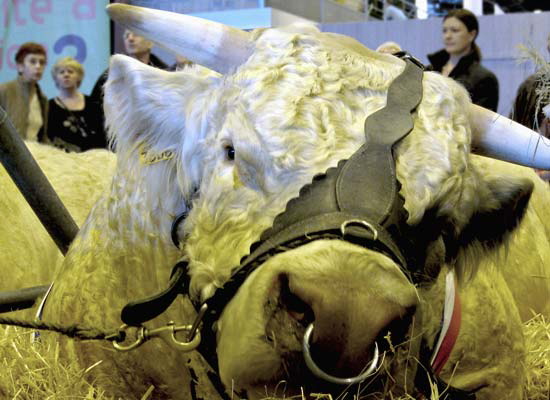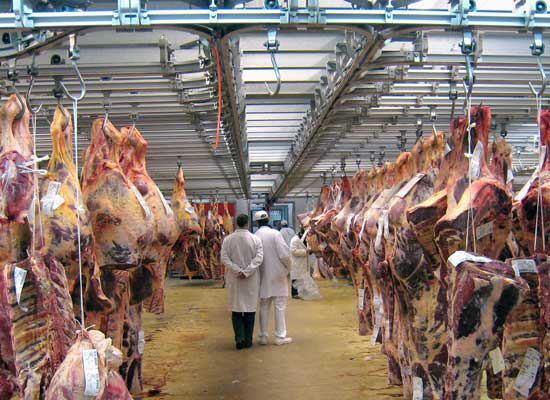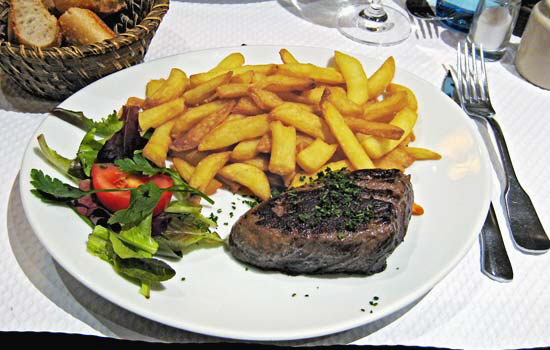|
Just Above Sunset |
||||
|
|
||||
|
|
|
|
The French Food Chain - Before, In-Between and After |
|
|
||||||||||||||||||||||||||
|
Our man in Paris, Ric Erickson, sends three shot from Paris, for the French foodies out there. He didn't send text other than the title. But one suspects he's been to the Salon International de l'Agriculture. When? Du 3 au 11 mars 2007 de 9h à 19 h. Where? Paris expo, Porte de Versailles. Perhaps he showed up of the "Nuit de l'agriculture" - Vendredi 9 mars 2007 jusqu'a 23h - or perhaps not. In any event, he sends a shot of this beast, the first link in the food chain. And damn, French cattle are just prettier than they should be - particularly the Charolais breed, from the area around Burgundy. We have a few over here - check out the American International Charolais Association for that. Oh, and don't forget those Limousin Cattle. You've got to start the food chain right. |
 |
|
This seems to be the Rungis Market - the central market of Paris, in the southern suburbs, the biggest wholesale food market in the world - "Le plus grand marché de produits frais au monde." Since the tenth century the central market of Paris was located in the center of the city, in a ten-acre area on the Right Bank, Les Halles. That became too small and in 1969 the market was transferred to the suburbs. Les Halles is now a big mall, Le Forum des Halles - there's GAP store, of course, and a Starbucks. What you saw in the move Charade (1963) - Audrey Hepburn and Walter Matthau having onion soup there in the middle of the night, discussing whether Cary Grant was a bad guy or not, while actual butchers on break wandered about in the background - happens there no more. Now they'd sip latte at Starbucks. Things change. In any event, the Rungis market is the property of the French State and administered by the Semmaris (Société d'Economomie Mixte d'Aménagement et de gestion du marché d'intérêt national de Rungis). It's a wholesale operation - open from one in the morning to seven in the morning - so all clients are professionals, distributors and restaurants. It is famed for its veterinary controls and property checkouts. They do things right. Sinclair Lewis wouldn't complain. In fact, the waste of the market is recycled and the energy generated by the cremation factory is used to heat the market - and nearby Orly Airport. How Ric got this shot is a mystery. But it's the middle step in the food chain. |
 |
|
The last link in the food chain is the French steak and frites (fries). See Solving the Mystery of French Steak - Anthony Bourdain in the New York Times - July 12, 2000 - I dug into my first real French steak, pan-seared, at a noisy, smoke-filled brasserie near Pigalle about 20 years ago. It was onglet, and I was immediately struck by its ropy, not-too-tender but not-too-tough texture and its strong, almost kidneyish flavor. This was not your generic slab of sirloin or rib-eye or pallid filet mignon. This was a cut of meat I'd never seen before. Strange, exciting, even a little scary. This, I thought, was eating. Today onglet is better known as hanger steak in New York, and it is so common it turns up in restaurants beyond French brasseries, and even in some meat markets. But the French steaks served alongside the frites can still be a mystery to most Americans, and it's not the meat but the cut that mystifies. These aren't simple sirloins or porterhouses or T-bones, and the differences are not just a matter of translation. For all their flavor, these steaks demand more of butcher and buyer alike. What's good - what's great - about French cuisine stems from its guiding principles, and no principle is more firmly ingrained in the minds and souls of French-trained chefs than the idea that one must "use everything." Use what's available. Use it to its best effect. And make the most money you can from it - every scrap of shank, shoulder and jowl. Back in the early days, when the meat supply was often erratic and refrigeration was at a minimum, frugal butchers had to make some shrewd moves to make a profit off a side of beef. They worked hard, often with the precision of desperate and money-hungry neurologists, rooting around with their knives, searching for gold deep inside the less-prized and less-expensive sections of carcass. At the time he was a chef at Les Halles in New York, working with Hubert Marie, a traditionally trained French butcher. And he explains it all. Click on the link. And he explains the sides - "Eat with plenty of vin ordinaire - and of course, frites. (If you can get some kidney fat off your butcher to fry those spuds, you are really living the good life.)" So we have the final link. |
 |
|||
|
Photos Copyright © 2007 - Ric Erickson, MetropoleParis |
|||
| [Just Above Sunset] [Commentary] [The International Desk] [Paris Beef] [Photography] [Diversions] [About] [Archives - Search] [Links and more...] [The Web Logs] |
|
Last updated Saturday, March 10, 2007, 10:30 pm Pacific Time |
|
All text and photos, unless otherwise noted, Copyright © 2003, 2004, 2005, 2006, 2007 - Alan M. Pavlik |
|
|
|